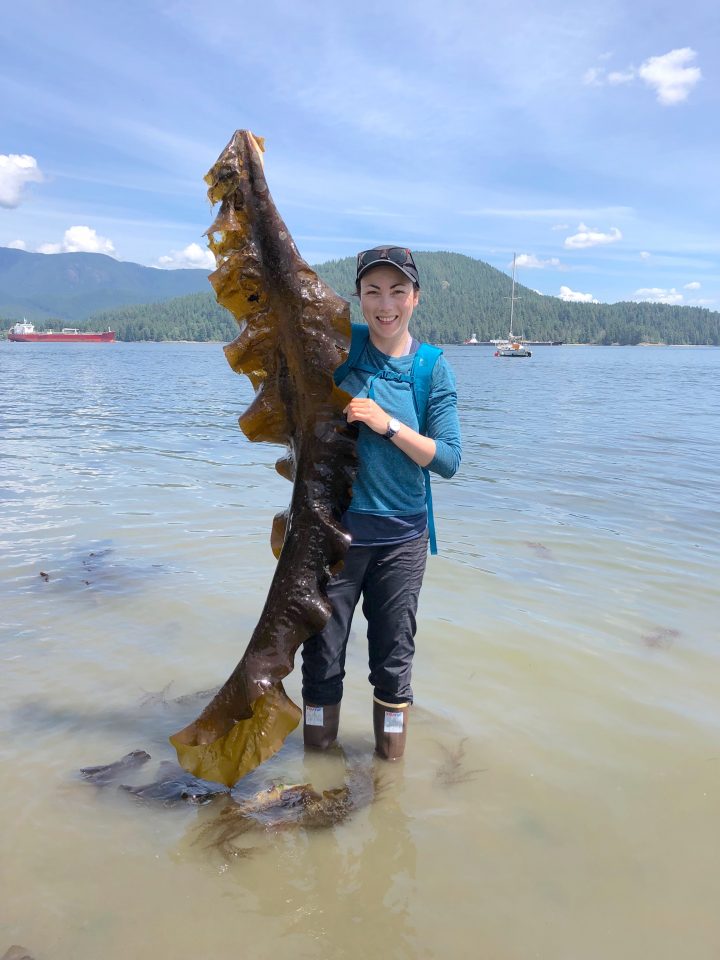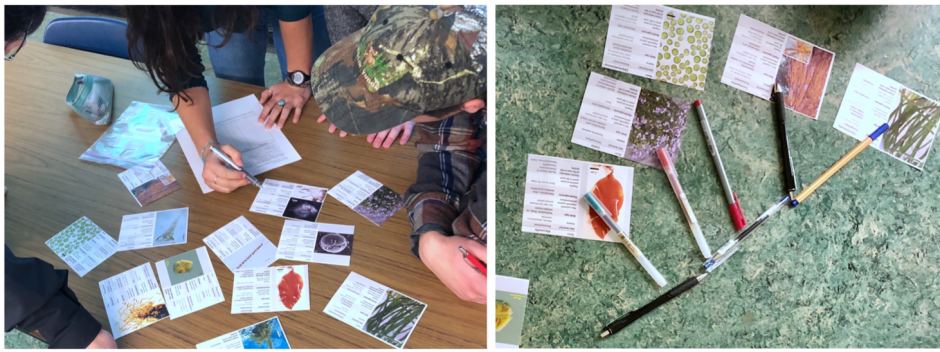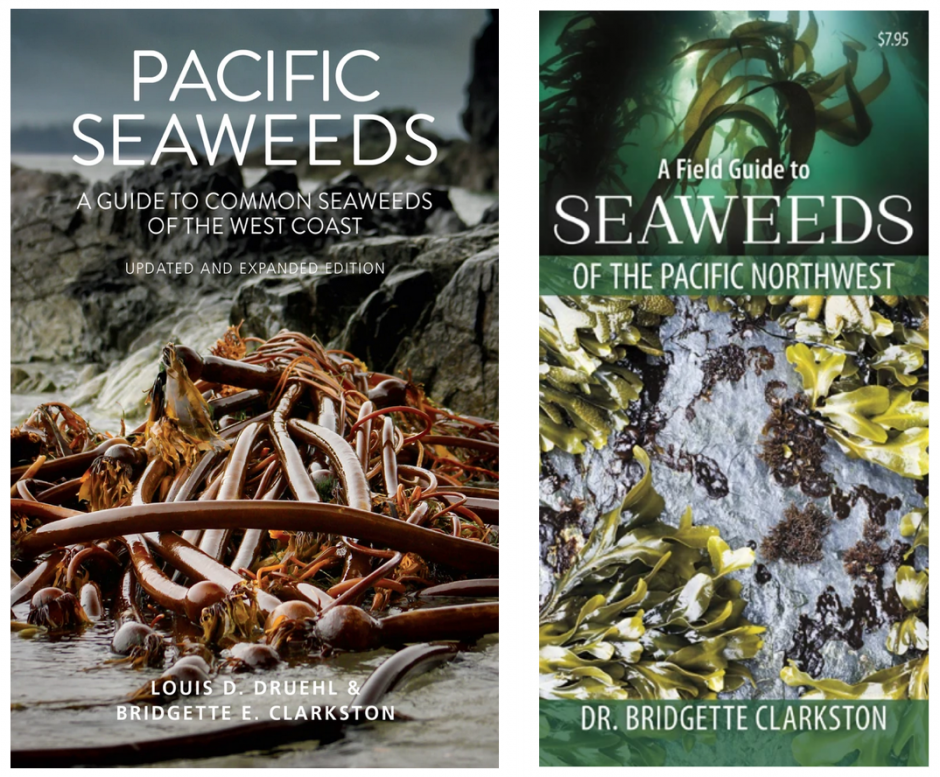
Associate Professor of Teaching
Academic History
- B.Sc. Biology, University of Victoria (2005)
- Ph.D. Biology, University of New Brunswick (2011)
- Postdoctoral Fellow, Carl Wieman Science Education Initiative, University of British Columbia (2012-2013)
My Links
Twitter feed: @funnyfishes – I’m most active here for work-related social media.
My personal professional website
Contact Information
- bridgette.clarkston@botany.ubc.ca
- 604-822-6495
- Office: Biological Sciences Building, room 2142
Awards
- Faculty of Science Achievement Award for Service (2013)
- Killam Teaching Award (2011).
Teaching Interests
In all of my UBC courses, I teach aspects of biodiversity: the sheer richness and complexity of life in all its forms, how we document and preserve records of diversity in literal “libraries of life” like the Beaty Biodiversity Museum, why we as a species rely on biodiversity for our very survival and well-being.

Measuring kelp specimens at the Beaty Biodiversity Museum for an activity about variation within species
My joy in teaching comes from seeing my students connect to nature, develop scientific literacy and feel empowered — especially in their first few semesters of university — to develop and pursue their educational goals. If I could take my ~200 first-year biology students to the Bamfield Marine Sciences Centre for their introductory biology courses, I would in a heartbeat. Since I can’t (yet), I bring nature into my students’ lives as much as possible.

Students in Bamfield working on their field-journals after a hike to Kiixiin, a 19th century Huu-ay-aht First Nations village and fortress
My general approach to teaching can be illustrated in four core practices:
- Bring evidence-based teaching and authentic practices into the classroom. The evidence supporting active learning is now legion; I am a big fan of getting students active and thinking during our precious class time together.
- Model habits of mind and the scientific process. For me, the discipline-specific content and skills I teach in any course go hand-in-hand with teaching relevant habits of mind: e.g., perseverance, flexible thinking, metacognition, thinking independently, taking ownership of learning, and applying past knowledge to new situations.
- Create an inclusive classroom for all students. I am committed to creating an inclusive classroom for all my students, regardless of gender, gender identity, sexual orientation, race, ethnicity, religion, disability, age or socio-economic status. I engage with the discourse around equity, diversity and inclusion happening within and outside UBC and work to bring best practices into my classroom so that all students feel safe, included and empowered to learn.
- Collaborate with teaching partners to maximize learning. Undergraduate courses are often taught in isolation of subsequent courses and programmatic goals. I work closely with my teaching colleagues within and between courses and consider program-level goals when developing my courses.

Students in Biology 209: Algae, Fungi & Bryophytes playing the Got Algae? Game on the first day of the Algae course theme
Courses Taught/Teaching
Recent courses taught at UBC:
- Biology 121: Genetics, Evolution, Ecology
- Biology 209: Biodiversity of Algae, Fungi & Bryophytes
- Biology 320: Survey of Algae (starting January 2021)
- Biology 336: Fundamentals of Evolutionary Biology (2018, 2019)

Buttons made by students during a Biol 209 lab activity to combine art, science and a chance to de-stress before exams
Community Work
Selected recent community work includes:
Phycological Society of America: Education Committee Chair (2019-current)
- Organize workshops for the annual society meetings. Recent offerings: Traditional Uses of Seaweeds w/ Dr. Dolly Garza, Introduction to R, Introduction to Taxonomic Nomenclature.
- Curate algae-related educational resources for the PSA website. Recent events: #TeachAlgae contest to solicit and publish 28 algae-related lessons from experienced university educators, a crowd-sourced list of algae-related resources for online teaching (over 100 resources, accessed 600+ times in summer 2020) & a match-making initiative to pair algae experts with classrooms (150 participants).
Raincoast Education Society: Seaweeds of the West Coast 3-day field course (created 2014, 2018-current).
- Immersive introduction to the wonderful world of seaweeds, co-taught with Dr. Katy Hind. Located in Tofino on the stunning West Coast of Vancouver Island.

Seaweed dishes cooked up during various workshops including: kelp noodles & bread, candied Egregia, Nori fries & sesame-oatmeal snaps, & Fucus stir-fry
Selected Publications
Peer-reviewed publications
Cooke, J.E, Weir, L. Clarkston, B.E. 2019. Retention following Two-Stage Collaborative Exams Depends on Timing and Student Performance. CBE—Life Sciences Education. 2019;18(2): ar12,1–ar12,8. https://www.lifescied.org/doi/full/10.1187/cbe.17-07-0137
Oehlman, N., Haeger, H., Clarkston, B.E. and Banks, J.E. 2016. Maximizing the Function of the Student ePortfolio: Demonstrating Learning in High-Impact Practices. Peer Review Summer 2016 (3) https://www.proquest.com/docview/1826255017?sourcetype=Scholarly%20Journals
Gilley, B. and Clarkston, B.E. 2014. Collaborative Testing: Evidence of Learning in a Controlled In–Class Study of Undergraduate Students. Journal of College Science Teaching 43(3): 83–91. http://bit.ly/1gtZyp4
Clarkston, B.E. and Saunders, G.W. 2013. Resolving species diversity in the red algal genus Callophyllis (Gigartinales, Florideophyceae) in Canada using an integrated taxonomic method. European Journal of Phycology 48(1): 27–46.
Clarkston, B.E. and Saunders, G.W. 2012. An examination of the red algal genus Pugetia (Kallymeniaceae, Gigartinales) with descriptions of Salishia firma gen. et comb. nov., Pugetia cryptica sp. nov., and Beringia wynnei sp. nov. Phycologia 51(1): 33–61.
Clarkston, B.E. and Saunders, G.W. 2010. A comparison of two DNA barcode markers for species discrimination in the red algal family Kallymeniaceae (Gigartinales, Florideophyceae), with a description of Euthora timburtonii sp.nov. Botany 88(2): 119−131.
Publications for a public audience
Pacific Seaweeds: A Guide to Common Seaweeds of the West Coast
Written with my longtime mentor and kelp world expert Dr. Louis Druehl, this updated and expanded guide (to Louis’ original 2002 edition of Pacific Seaweeds) thoroughly documents every aspect of seaweed life, from species identification and seaweed biology to the essential—and often surprising—roles seaweed plays in the marine ecosystem and our everyday lives. Seaweeds are used in everything from cosmetics to sustainable biofuels, and some species, like kelp, contribute to the remediation of coastal ecosystems. Features 247 seaweed species in 121 genera, which breaks down to 40 species of greens, 119 reds, 78 browns, 5 seagrasses and 5 shore plants. Lots to explore!
A Field Guide to Seaweeds of the Pacific Northwest
The pocket-sized Field Guide to Seaweeds of the Pacifc Northwest is packed with full-colour photos and information on a select variety of the most important and interesting seaweeds commonly encountered on the West Coast. Whether you want to identify seaweeds, better understand their role in the ocean, forage for food, collect for art or you’re just plain curious as you poke around the seashore, this educational guide is your ultimate source for casual phycological fun.
You can find both publications on the Harbour Publishing Website







